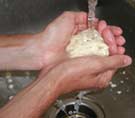|
Why
is gluten so important? Without it, there would be nothing
to hold the gas that makes bread rise.
Think
of gluten as the rubber of a balloon: The stronger it is,
the more gas it can hold.
But stronger isn’t always better. For many baked goods,
like pastries and pie crusts, it’s important to avoid
gluten development.
That’s
why different flours contain different amounts of protein,
depending on how they are meant to be used. A high-protein
flour will make a dough with strong gluten, good for hearty
yeast breads. Pastry chefs, on the other hand, prefer low-protein
flours that yield delicate, tender doughs.
The following activity is a great way to get a feel for gluten,
and to find out why using different flours can lead to such
different results.
Recipe
Conversions
|
 CAUTION
CAUTION
Kids, please don’t try this at home without the help
of an adult.
|
|
|
|
|
What
Do I Need?
|
.
|
|
•
Any combination of the following flours:
whole wheat flour
bread flour
all-purpose flour
pastry flour
gluten flour
instant flour
|
 Did
You Know?
Did
You Know?
Shortening—whether it’s butter, margarine, or
lard—interferes with the way the gluten-forming proteins
in flour interact with water. This makes for short strands of
gluten, which is the key to flaky pastries and crusts.
 Did
You Know?
Did
You Know?
Whole wheat flour contains about 14% protein, while
pastry flour might contain half as much. You can find out how
much protein is in a flour by looking at the nutritional information
on the package, or by
clicking
here
.
|

|
|
•
water (1/2 to 3/4 cup for each flour you
’
ll
be using)
• bowls (one for each flour you
’
ll
be using)
|
|
|
|
|
|
What
Do I Do?
|
|
|
1.
Into
separate bowls, measure out 1 cup of each of your flours.
If your bowls look different, remember which one contains
which type of flour. If not, label them.
|
|
|
|
|
2.
Slowly add about 1/2 to 3/4 cup water to the flour in
each bowl, and knead each mixture until it forms a soft, rubbery
ball of dough. Let the dough balls sit for about 10 minutes.
|
|
|
|
3.
In
the sink, run cold water over one of the dough balls. Be careful
not to let the dough disintegrate; try cupping your hands
around the ball and squeezing gently to remove the starch.
With low-gluten cake or pastry flours, you may want to put
the dough in cheesecloth in order to hold it together.

|
|
|
|
4.
You’ll notice the water turning milky as it washes
away the starch in the dough. Keep pouring out the cloudy
water that collects in the bottom of the bowl. Slowly, your
dough ball will become a gummy, slimy network of gluten strands.

|
|
|
|
5.
When the water no longer becomes milky, you know there’s
no more starch in the dough, leaving nearly pure gluten. Notice
how much smaller your ball has become—and how much more
stretchy!
|
|
|
|
6.
Repeat steps 3 to 5 for each of your flour types. How
does the texture of each one differ as you wash away the starch?
Does it take the same amount of time for each one? Are the
gluten balls all the same size, or are some larger than others?

|
|
|
|
|
7.
Now try baking your gluten balls in the oven for about 15–30
minutes at 450° F. When you take them out of the oven, you’ll
notice they’ve puffed up and hardened, which is exactly
what happens to the gluten in a loaf of bread as it bakes.
|
 Did
You Know?
Did
You Know?
Gluten is both plastic—able to change shape—and
elastic—able to spring back into place.
|
|
|
|
|
What’s
Going On?
|
.
|
|
When
you knead dough, you help two proteins in wheat flour,
gliadin
and
glutenin,
form gluten. But flour also contains
many other components—starch, lipids, sugars, and enzymes—that
contribute to the consistency and nutritional value of bread.
When you run water over dough in this activity, you wash away
most of these other substances, isolating the gluten in the
dough. In the oven, the steam produced as the gluten heats
up expands the ball. Finally, the gluten hardens, and you
have a finished gluten ball.
Click
here
to learn more about how gluten is formed.
|
 Did
You Know?
Did
You Know?
Gluten is not only used in baking. It’s also great for
“beefing up” vegetarian cooking.
|
|
|
|
|
What
Else Can I Try?
|
.
|
|
In baking, gluten is mainly used for the light texture and
distinct taste it gives bread. But it’s also nutritious
in its own right. It is, after all, almost pure protein. And
because of its chewy texture, many people—especially
vegetarians—find it to be an excellent addition to stir-fries
and stews.
The
gluten you extracted in the previous activity is technically
edible. But you can make it much more palatable by flavoring
it with soy sauce, ginger, garlic, and seaweed. The finished
product, known as
seitan
, is a great source of texture
and protein.
To
find out more about seitan—and to learn how to make it—check
out this
Vegetarian Journal article
:
http://www.vrg.org/journal/vj96mar/vjseitan.htm
.
For
more about flour and dough, check out these
links
.
|
 Did
You Know?
Did
You Know?
Recipes for cornbread and pancakes often warn you not to mix
the batter too much. For these breads, overmixing can make
the gluten too strong, which makes for a tough, chewy finished
product.
 Share
& Discuss
Share
& Discuss
Talk about your results.
|
|
|
